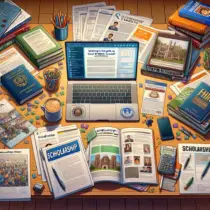Unveiling the Path to Your Dream School: Tips for Choosing the Perfect Scholarship
Introduction:
For many individuals, attending their dream school is an aspiration that can be limited by financial constraints. Scholarships have become a crucial means of bridging this gap, providing opportunities for deserving students to pursue their education at their desired institutions. However, with countless scholarships available, it can be overwhelming to choose the perfect one that aligns with your goals and aspirations. This article aims to guide students in selecting the ideal scholarship and unveiling the path to their dream school.
1. Understand the Types of Scholarships:
Before delving into the search for a scholarship, it is essential to understand the different types available. Scholarships can be merit-based, need-based, talent-based, or diversity-based. Merit-based scholarships are awarded based on academic achievements or extracurricular involvement, while need-based scholarships consider financial needs. Talent-based scholarships focus on specific talents such as sports or arts, and diversity-based scholarships aim to promote inclusivity among underrepresented groups.
2. Reflect on Your Goals and Aspirations:
To choose a scholarship that aligns with your goals and aspirations, take some time for self-reflection. Consider your intended field of study and long-term career objectives. Determine if you have any particular talents or achievements that could make you eligible for specialized scholarships. Understanding your passions will help narrow down scholarship options that cater to your interests.
3. Research Extensively:
Gather as much information as possible about different scholarships offered by various institutions or organizations. Start by exploring local resources such as community organizations or foundations that may provide scholarships targeted at students from your area. Additionally, research national and international scholarship opportunities through websites dedicated to compiling comprehensive lists of available scholarships.
4. Eligibility Criteria:
Pay close attention to each scholarship’s eligibility criteria before applying. Some scholarships may require specific GPA requirements, standardized test scores such as SAT or ACT results, or letters of recommendation. Others may want to see evidence of your involvement in extracurricular activities or community service. Ensure you meet all the criteria before devoting time to an application, as this will increase your chances of success.
5. Financial Considerations:
Scholarships differ in their financial coverage, so it is essential to assess your financial needs and the extent to which scholarships can help reduce your expenses. Some scholarships provide full tuition coverage, while others may only contribute a portion of the costs. Additionally, consider whether scholarships offer additional benefits such as housing allowances or book stipends.

6. Reputation and Prestige:
Another crucial factor in choosing a scholarship is considering the reputation and prestige associated with it. Scholarships from well-established institutions or renowned organizations can provide added credibility and recognition on your resume. Research the impact previous recipients have made after receiving the scholarship and assess how it can enhance your educational journey.
7. Scholarship Requirements:
Different scholarships may have varying requirements beyond academic performance and financial need. Some may require recipients to maintain a certain GPA throughout their studies or enroll in specific courses related to their field of study. Ensure you are aware of any additional obligations associated with the scholarship before applying, as these requirements could affect your academic flexibility.
8. Application Process:
Understanding the application process for each scholarship is vital for managing time effectively and preparing quality applications tailored to each opportunity. Take note of application deadlines, required documents, essay prompts, interview processes, and any other necessary steps involved in applying for scholarships.
9. Seek Assistance:
Do not hesitate to seek guidance from teachers, mentors, or school counselors who can provide valuable insights into navigating scholarship opportunities. They can assist you in identifying scholarships suited to your abilities and guide you through the application process.
10. Take Advantage of Multiple Opportunities:
Instead of solely relying on one scholarship opportunity, diversify your options by applying for multiple scholarships that suit your qualifications and aspirations. This increases your chances of success and provides backup options if some scholarships do not work out.
Conclusion:
Choosing the perfect scholarship can be a daunting task, but with careful consideration and thorough research, it becomes an empowering journey. By understanding the types of scholarships available, reflecting on personal goals, researching extensively, assessing eligibility criteria and financial considerations, considering reputation and requirements, understanding the application process, seeking assistance from mentors, and exploring multiple opportunities, you can unveil the path towards your dream school. Remember that perseverance is key in searching for and applying to scholarships – stay focused and dedicated to achieving your aspirations.







